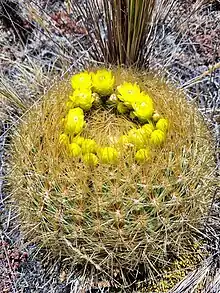| Oroya borchersii | |
|---|---|
 | |
| Scientific classification | |
| Kingdom: | Plantae |
| Clade: | Tracheophytes |
| Clade: | Angiosperms |
| Clade: | Eudicots |
| Order: | Caryophyllales |
| Family: | Cactaceae |
| Subfamily: | Cactoideae |
| Genus: | Oroya |
| Species: | O. borchersii |
| Binomial name | |
| Oroya borchersii (Boed.) Backeb. 1958 | |
| Synonyms | |
| |
Oroya borchersii is a species of cacti (family Cactaceae), originating from Peru[2]
Description
Oroya borchersii grows individually or forms groups with shoots that reach heights of 12 to 32 centimeters with diameters of 15 to 22 centimeters. There are 12 to 30 ribs. The brown areoles are elongated. The yellowish to reddish brown, 2 to 2.5 centimeter long thorns are difficult to distinguish between central and peripheral thorns. There are 1 to 3 central spines and 25 to 30 thin, needle-like to bristle-like, comb-shaped marginal spines.
The yellow to greenish yellow flowers are up to 2 centimeters long and reach a diameter of 1.5 centimeters. The club-shaped fruits are yellow-green and up to 2.5 centimeters long.[3]
 Flowers closeup in habitat
Flowers closeup in habitat Plant growing in Tucson Botanical Gardens, Tucson, Arizona
Plant growing in Tucson Botanical Gardens, Tucson, Arizona
Distribution
Oroya borchersii is widespread in the Ancash region of Peru in the Cordillera Blanca and the Cordillera Negra at altitudes of 3900 to 4300 meters.
 Plants growing in habitat in Ancash
Plants growing in habitat in Ancash
Taxonomy
The first description as Echinocactus borchersii was published in 1933 by Friedrich Bödeker. Curt Backeberg placed the species in the genus Oroya in 1958.[4]
References
- ↑ "The IUCN Red List of Threatened Species". IUCN Red List of Threatened Species. 2011-05-07. Retrieved 2023-09-16.
- ↑ "Oroya borchersii (Boed.) Backeb. — Plants of the World Online". Plants of the World Online. Retrieved 2023-09-16.
- ↑ Anderson, Edward F.; Eggli, Urs (2005). Das grosse Kakteen-Lexikon (in German). Stuttgart (Hohenheim): Ulmer. p. 485–486. ISBN 3-8001-4573-1.
- ↑ "Au Cactus Francophone :". Au Cactus Francophone (in French). Retrieved 2023-09-16.
External links
 Media related to Oroya borchersii at Wikimedia Commons
Media related to Oroya borchersii at Wikimedia Commons Data related to Oroya borchersii at Wikispecies
Data related to Oroya borchersii at Wikispecies
